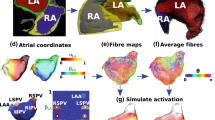Abstract
The anisotropic electrical conduction within myocardial tissue due to preferential cardiac myocyte orientation (‘fibre orientation) is known to impact strongly in electrical wavefront dynamics, particularly during arrhythmogenesis. Faithful representation of cardiac fibre architecture within computational cardiac models which seek to investigate such phenomena is thus imperative. Drawbacks in derivation of fibre structure from imaging modalities often render rule-based representations based on a priori knowledge preferential. However, the validity of using such rule-based approaches within whole ventricular models remains unclear. Here, we present the development of a generic computational framework to directly compare the fibre architecture predicted by rule-based methods used within whole ventricular models against fibre structure derived from DTMRI data, and assess how relative differences influence propagation dynamics throughout the ventricles. Results demonstrate the close overall match between the methods within the rat ventricles, and highlight regions for potential rule-adaption.
Preview
Unable to display preview. Download preview PDF.
Similar content being viewed by others
References
Alexander, A.L., Hasan, K.M., Lazar, M., Tsuruda, J.S., Parker, D.L.: Analysis of partial volume effects in diffusion-tensor MRI. Magn. Reson. Med. 45, 770–780 (2001)
Clerc, L.: Directional differences of impulse spread in trabecular muscle from mammalian heart. J. Physiol. 255, 335–346 (1976)
Fenton, F., Karma, A.: Fiber-rotation-induced vortex turbulence in thick myocardium. Phys. Rev. Lett. 81, 481–484 (1998)
Hooks, D.A., Tomlinson, K.A., Marsden, S.G., LeGrice, I.J., Smaill, B.H., Pullan, A.J., Hunter, P.J.: Cardiac microstructure: implications for electrical propagation and defibrillation in the heart. Circ. Res. 91, 331–338 (2002)
Mahajan, A., Shiferaw, Y., Sato, D., Baher, A., Olcese, R., Xie, L.H., Yang, M.J., Chen, P.S.: A rabbit ventricular action potential model replicating cardiac dynamics at rapid heart rates. Biophys. J. 94, 392–410
Peryat, J.-M., Sermesant, M., Pennec, X., Delingette, H., Xu, C., McVeigh, E., Ayache, N.: A computational framework for the statistical analysis of cardiac diffusion tensors: application to a small database of cannine hearts. IEEE Trans. Med. Imag. 26, 1–15 (2007)
Plank, G., Burton, R., Hales, P., Bishop, M.J., Mansoori, T., Bernabeau, M., Garny, A., Prassl, A.J., Bollensdorf, C., Mason, F., Rodriguez, B., Grau, V., Schneider, J., Gavaghan, D.J., Kohl, P.: Generation of histo-anatomically representative models of the individual heart: tools and application. Phil. Trans. Roy. Soc. (2009)
Potse, M., Dube, B., Richer, J., Vinet, A., Gulrajani, R.M.: A comparison of monodomain and bidomain reaction-diffusion models for action potential propagation in the human heart. IEEE Trans. Biomed. Eng. 53, 2425–2435 (2006)
Prassl, A.J., Kickinger, F., Ahammer, Grau, v.H., Schneider, J.E., Hofer, E., Vigmond, E.J., Trayanova, N.A., Plank, G.: Automatically Generated, Anatomically Accurate Meshes for Cardiac Electrophysiology Problems (2008) (under review)
Qu, Z.L., Kil, K., Xie, F.G., Garfinkel, A., Weiss, J.N.: Scroll wave dynamics in a three-dimensional cardiac tissue model: roles of restitution, thickness and fiber rotation. Biophys. J. 78, 2761–2775 (2000)
Scollan, F., Holmes, F., Winslow, R., Forder, J.: Histological validation of myocardial microstructure obtained from diffusion tensor magnetic resonance imaging. Am. J. Physiol. Heart Circ. Physiol. 275, 2308–2318 (1998)
Seemann, G., Keller, D.U.J., Weiss, D.L., Dössel, O.: Modelling human ventricular geometry and fiber orientation based on diffusion tensor MRI. Proc. Comp. Cardiol. 33, 801–804 (2006)
Streeter, D.D., Spontnitz, H.M., Patel, D.P., Ross, J., Sonnenblick, E.H.: Fiber orientation in the canine left ventricle during diastole and systole. Circ. Res. 24, 339–347 (1969)
Weiss, D.L., Keller, D.U.J., Seemann, G., Doessel, O.: The influence of fibre orientation, extracted from different segments of the human left ventricle, on the activation and repolarization sequence: a simulation study. Europace 9, 96–104 (2007)
Author information
Authors and Affiliations
Editor information
Editors and Affiliations
Rights and permissions
Copyright information
© 2009 Springer-Verlag Berlin Heidelberg
About this paper
Cite this paper
Bishop, M.J., Hales, P., Plank, G., Gavaghan, D.J., Scheider, J., Grau, V. (2009). Comparison of Rule-Based and DTMRI-Derived Fibre Architecture in a Whole Rat Ventricular Computational Model. In: Ayache, N., Delingette, H., Sermesant, M. (eds) Functional Imaging and Modeling of the Heart. FIMH 2009. Lecture Notes in Computer Science, vol 5528. Springer, Berlin, Heidelberg. https://doi.org/10.1007/978-3-642-01932-6_10
Download citation
DOI: https://doi.org/10.1007/978-3-642-01932-6_10
Publisher Name: Springer, Berlin, Heidelberg
Print ISBN: 978-3-642-01931-9
Online ISBN: 978-3-642-01932-6
eBook Packages: Computer ScienceComputer Science (R0)




